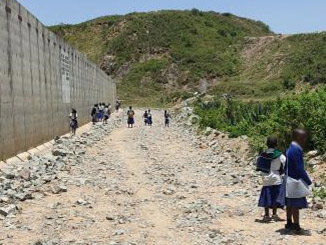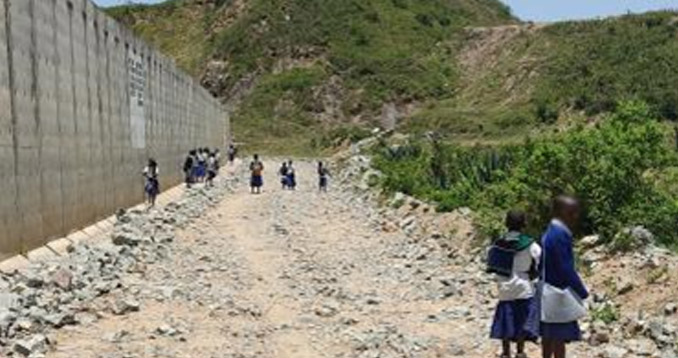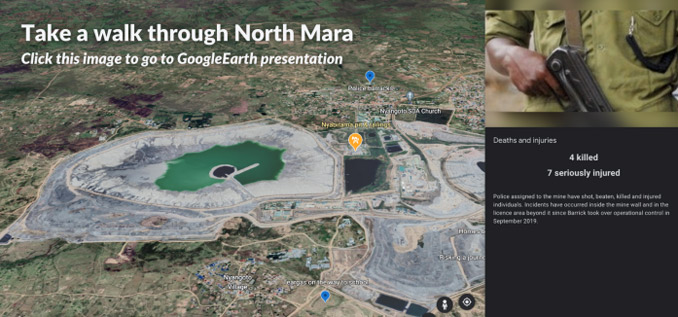

At least four people have been killed and seven more seriously injured by police engaged to provide security at Tanzania’s North Mara Gold Mine since Barrick Gold assumed control of the mine in September 2019, UK corporate watchdog RAID says. The alarming human rights abuses shatter the Canadian mining giant’s claim that it has “radically repaired” community relations at the mine, after taking back operational control from its UK subsidiary, Acacia Mining.
“Barrick’s claims that it has tackled human rights abuses at the North Mara mine just don’t stack up. The shootings and beatings by Tanzanian police assigned to the mine are a world away from Barrick’s rosy sustainability reports and partial assessments. Barrick’s board and investors should ensure an end to the mine’s relationship with the police and set up a truly credible and independent investigation into the abuses,” says Anneke Van Woudenberg, Executive Director at RAID
Barrick subsidiaries are in a British court to face allegations of unlawful killings and assaults at the mine between 2014 and 2019. The claimants include the family of a nine-year-old girl killed by a mine vehicle driven by police, and four women who were fired upon while gathering around her body. Barrick’s subsidiaries deny liability.
RAID has conducted six research missions to North Mara and interviewed more than 90 people over the past 28 months, following up on reports that the human rights situation remained of serious concern. RAID’s team interviewed those injured, their families, witnesses, local authorities, village leaders, police officers, security personnel and former mine employees, who provided credible information about new killings and assaults by Tanzanian police assigned to the mine, identified by local residents as “mine police”. The vast majority of the human rights incidents occurred in the past 12 months.
According to witnesses, three of those killed were attempting to leave, or had been chased from, the mine site. Two were shot with live ammunition while the third was struck with a large projectile, possibly a teargas canister or sound bomb, in the back of his head. RAID found no evidence that the force used by police was proportionate or necessary.
Officers identified as mine police were also reported to beat local residents. In one case, police broke into the home of a local resident, Joseph (not his real name), who they accused of being an “intruder”. According to Joseph, police who guard the mine dragged him into the yard saying, “This is one of those who are giving us problems.” They hit him repeatedly on the head, kicked and beat him.
Local leaders and residents deplored the actions by the “mine police” who they said regularly invade residential areas, force their way into homes without a warrant, arbitrarily arrest and beat residents, and fire teargas and ammunition indiscriminately, including near children. Police guarding the mine are described as being armed with rifles, submachine guns, batons, teargas launchers and sound bombs. According to a village chairman, “The mine police… always look like they’re going to war.”
In one incident in January 2022, police guarding the mine fired teargas near children on their way to school. A grandmother who was passing nearby told RAID she heard the teargas discharge and saw the smoke. “I heard the cries of the children who were going to school. I felt so bad, but I wasn’t in a position to help, and some of the children started to choke.” She said the “mine police” laughed at the crying children, telling them “we brought you corona [Covid-19] medicine.” RAID researchers found remnants of multiple teargas canisters near homes around the mine.
In reply to RAID’s request for information on the reports of recent killings and assaults, Barrick said, “it would not be appropriate to discuss any allegations raised by RAID outside of the English High Court proceedings”, though RAID is not a party and the allegations do not concern incidents subject to those proceedings.
The mine’s relationship with the police
The mine has a Memorandum of Understanding (MoU) with the Tanzanian police, under which an estimated 100 to 150 police are assigned to provide security at the mine. They include both regular officers and members of Tanzania’s Field Force Unit, a specialist division responsible for riot control. The mine pays, feeds, accommodates and equips them. In response to the allegations, Barrick said that references to “Mine Police” are “factually incorrect”, and that the mine does not employ, “supervise, direct or control” police assigned to it, and is not responsible for their conduct.
However, nine members of the mine’s internal security team and the police interviewed by RAID, described how police assigned to the mine were part of the mine’s security structure and were overseen by its security team. They said police are present in the mine’s security control room where security operations are monitored and directed; are deployed to specific areas around the mine site; use the same radio frequency as the mine’s security team; and regularly bring individuals arrested at the mine site to be photographed and processed by the mine before being taken away, raising concerns regarding the rights of detainees.
Former members of the mine’s internal security team raised concerns about the mine’s relationship with the police. Those interviewed by RAID said the mine’s extensive use of the police increased security risks due to the police’s persistent unlawful conduct. One said, “to be honest, the police are a nightmare. How can you have a situation where the people who are meant to uphold the law are the worst example of breaking the law?”
RAID has repeatedly raised concerns about the behaviour of the police assigned to the mine, urging Barrick and its subsidiaries to consider ending the company’s reliance on the police for its security needs.
Barrick said that it “seeks to avoid causing or contributing to human rights violations,” that the human rights concerns at the mine are “legacy issues” and that the relationship with the Tanzanian police was reviewed “to establish clear boundaries” since bringing the North Mara mine back under its control. It says third party human rights assessments conducted at the mine since 2019, the most recent in early 2022, found
“considerable improvement…[on] security matters at the mine since Barrick took over operational control.”
“Unpublished assessments conducted at the mine have been commissioned or largely influenced by Barrick, so it’s no surprise they are at odds with distressing accounts from local residents,” said Van Woudenberg. “Whatever recent ‘boundaries’ Barrick may say it has in place with the police does not alter the fact that the company continues to engage, pay and equip abusive and unaccountable police to guard its mine.”


Leave a Reply